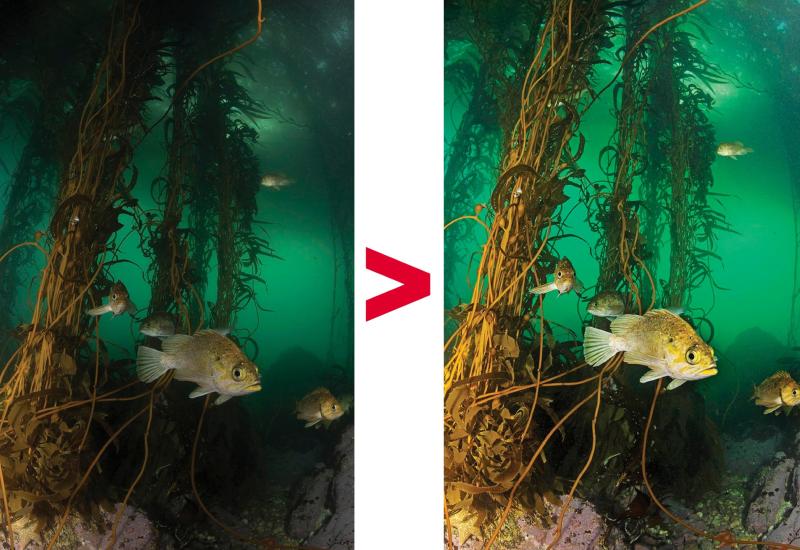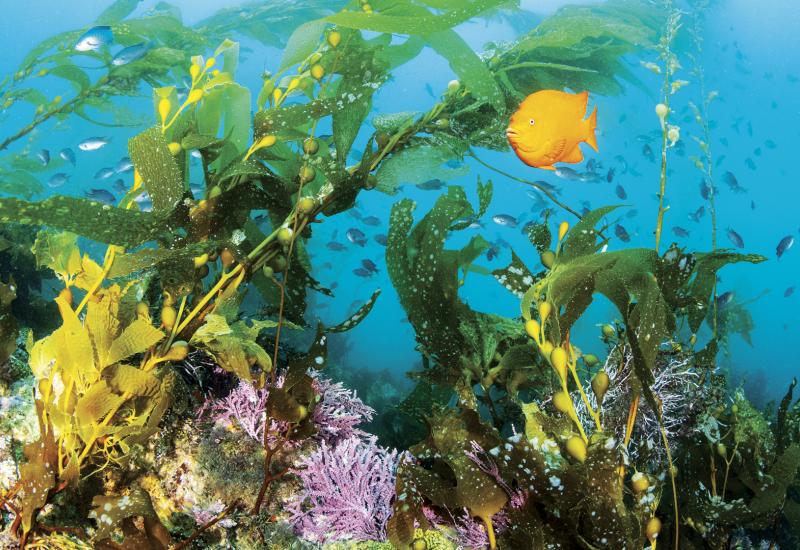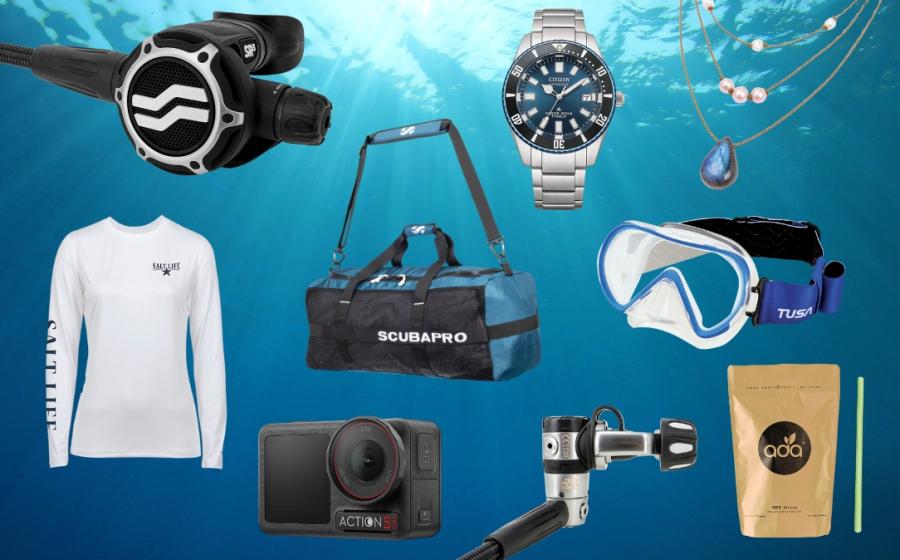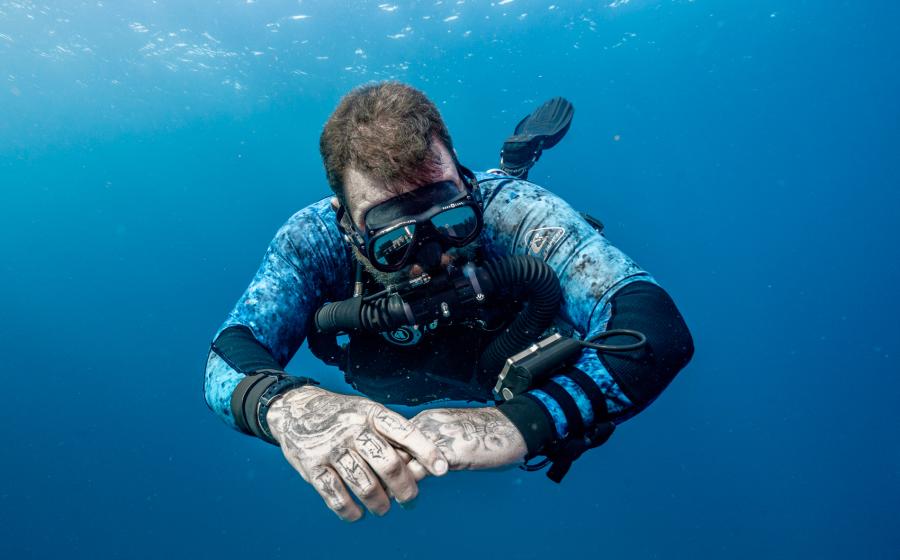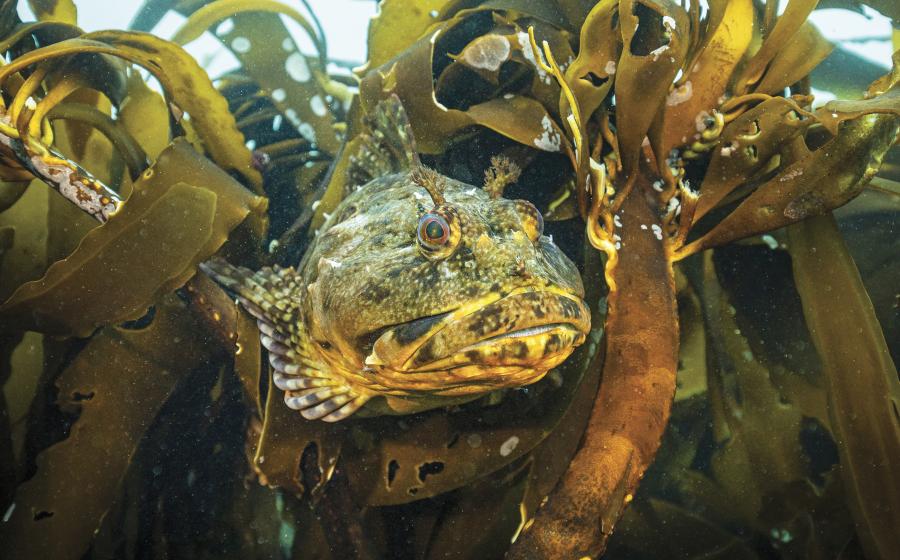Getting Mucky With It: 18 Muck-Diving Creatures
Can we talk muck? And by that, I mean dirty diving.
Muck diving is all the rage these days. It is a bit of a surprising trend, as you would think most divers really just want to see pretty, healthy reefs.
But muck diving? Not so much on the pretty reefs. As its name suggests, the bottom is typically fairly flat with varying amounts of soft substrate, ranging from rubble and coarse sand to fine silt. Occasionally, there are small coral heads and rocks that crop up. These become islands of life in what otherwise, at first glance, appears to be bit of a non-starter.
On my initial muck dive at Tulamben in Bali, I was at first fooled by the lack of reef features and felt a bit disappointed about diving in an apparent wasteland. But then discoveries started to be made — in and on that sand, silt and rubble, all sorts of creatures were being spotted: snake eels, jawfish, burrowing octopus, tube worms, harlequin shrimps and gobies with their partner shrimps. An anemone can be an island, as can a small boulder of coral that becomes the local cleaning station. Nudibranchs can be easier to spot, as they perambulate across the ocean’s deserts, seeking food or mates. Every small fern-like hydroid should be checked out, looking for the highly entertaining (and tiny!) colonies of skeleton shrimp that may be in residence. You are sure to spot some crabs scuttling from here to there. The bizarre stargazer is a fish that burrows into soft bottoms. As do snake eels. Crocodilefish can be found there, too. And the only flamboyant cuttlefish I’ve seen (in Indonesia and in the Philippines) were on muck sites.

Judy GA Pair of Coleman Shrimp
These beautiful little shrimps make their home on Variable Fire Urchins, which are large, super colorful and highly venomous! Technically, the shrimps themselves are not on the muck, but the urchins are found there, usually below 60 feet in depth. The shrimps clear-cut a little spot on the urchin by nipping off the spines with their sharp claws, and there they reside. I am particularly proud of this shot, as I found these shrimps myself (the larger one is less than 1 inch long) after looking for them on many, many urchins in Bima Harbor in Sumbawa, Indonesia.
Some great muck diving that I’ve done was over pretty clean sand (Bali’s Tulamben area and an area called Dumaguete in the Philippines), while other great muck diving (Lembeh, Ambon Harbor, Bima Harbor – all in Indonesia) was done over deep, fine, not-so-clean silt. In the case of Ambon, the silt at what many consider to be one of the best muck diving sites in the world — Laha — is littered, literally, with detritus: garbage, old bicycles, discarded shoes and clothing, etc. It is not pretty, but it is a mecca for macro photographers who are keen to dive in this dirty harbor. The variety of unusual creatures that can be found in Ambon is extraordinary, including the elusive psychedelic frogfish and the much-sought-after Rhinopias — a very funky branch on the scorpionfish family tree.
Muck diving and muck photography require some specialized diving skills. If you’ve ever been in a dust storm, you can relate to how quickly visibility can go from normal to non-existent, as the particles are whipped up and clog the air. Well, the same thing happens underwater when the silt is disturbed — it can cause a veritable whiteout as the particles become suspended in water, and it can take a very long time to resettle. In a cave or inside a wreck, this can be life threatening. On a dive it is frustrating, so careless divers who kick up the silt are very unpopular on muck dives. And it is a major faux pas to have a look and/or take your shots of something and then leave the scene carelessly, so that the shot is ruined for others waiting their turn.
The best technique is to dive with fins up. Swimming with the body and upper legs in one horizontal line, bend your knees up 90 degrees with your feet flexed so your fins are parallel to your body, but above it. Then, instead of the traditional scissor kick with the fins, which will lift silt from the bottom even when a diver is swimming several feet above it, swirl your fins in a sculling motion with your lower legs, ankles and feet. This way, you can swim very close to the bottom without disturbing it. If you practice, you can even use your fins in this position to go backward! And don’t forget to look behind as you muck dive; that can tell you whether you are diving without disturbing the bottom.
Another really important detail is to make sure to tuck up your junk. Seriously, nothing says ‘newbie’ more than a diver bungling along, completely unaware that his or her gauges, octo or other gear is banging along the reef or dragging through the sand below. Besides potentially damaging the reef, it’s also not good for the gear.
Here is a shot of my good buddy Mike demonstrating his excellent trim and fin placement. Although this shot was taken up over a reef — not down close to muck — it is a good illustration of the body position that I am describing.

Judy GHaving good trim and fin placement is crucial to a successful muck dive.
One must-have, in my opinion, is a muck stick. Typically this is a long (14-18 inches or so), slender metal wand. A good stick has an ergonomic handle, a wrist lanyard and a clip to attach it to your BC when not in use. The technique is to use it as you move in to closely view a creature or to set up your shot. Put the tip of the muck stick in a convenient location, making sure that wherever you plant it is dead (i.e., not on coral, sponges, anemones or anything else that could be alive). When inserting it into muck (and that could be up to the hilt in silt in places like Lembeh!), proceed slowly in case there is something lurking under the surface. In fact, no matter where you put it, look super carefully first. On a night dive in Ambon Harbor, I went to put my stick on a rock to set up for a photo, and the rock moved — it was a stonefish! These are highly venomous fish and masters of camouflage. That could have been very ugly, especially if I was using a finger or a hand instead of a stick!
The stick allows you to have a pivot point and a push point to get up and away from the reef. Using it correctly means that no part of your body, including your fins, ever touches the bottom. I believe it is the cleanest possible way to dive close to the reef and to take photographs. It is also the safest in my opinion — avoiding putting a finger or two on the reef by using a stick means you’ll never get nailed by a stinging hydroid or the spines of a camouflaged creature. I take mine on every dive I do. And I am not saying I am perfect and have never made a mistake and had inadvertent contact. We all do. But using the stick, tucking up the gear and diving with the correct trim really help to limit these boo-boos.
There has been some debate about muck sticks, mostly because some people believe that divers might feel free to use them to manipulate subjects (to tease things out of holes or move things to a different location for a better photograph, as examples). Most conscientious divers I know feel that is really wrong and don’t engage in this behavior.
My stick is both my camera monopod and the thing I use to steady myself so I have no contact with the reef. It has also come in handy on some wicked current dives, during which I was able to use it to hold me in place as I was being swept along and to rest after getting winded swimming into strong current.
On a recent trip to Thailand, I was really dismayed to see an experienced diver and photographer (he said he had more than 1,000 dives) grabbing onto live corals with his whole hand to steady himself while taking photos. In some cases, he laid his whole body down on the coral to get his shot. To think that he has been doing that for many years would suggest he has left a trail of broken or damaged corals in his wake. It was also surprising to me that no dive guide had apparently ever called him out on this practice. This guy would do so much less damage by using a stick. No shot is worth wrecking the reef.
Here is a parade of muck critters to illustrate what kind of awesome stuff can be seen on “barren” dive sites. Most of these were shot in Asia, but a couple of them are also from my recent trip to CoCo View Resort in Roatan, and I even popped in a Dungeness crab I shot a couple of weeks ago on a mucky dive near my home in British Columbia.
Mimic Octopus
This clever little octopus creates its burrow in the sand. Often, all you will see is a small head popping up, and that is likely to disappear when you approach. Thus, patience is required to photograph this animal. When the octopus is out and about, it is capable of taking the shape of other reef creatures as a way to stealthily hunt and to evade predators. I have seen them completely change color and take on the flat form of a flounder. These things can get to be quite large — about 12 inches from tip to tip.

Judy GMimic Octopus
Three Lobed T-Bar Nudibranch
This beautiful nudibranch is quite big — about 3 inches long, so fairly easy to spot as it travels across sandy bottoms. I am a self-confessed nudi nut — I absolutely love the wacky shapes, colors, and behaviors of these fascinating sea slugs. There are hundreds and hundreds of varieties of them (with more being discovered all the time), and I am always looking to add to my photo collection of them.

Judy GThree Lobed T-Bar Nudibranch
Spiny Tiger Shrimp
This is an unusual creature — I’ve only seen a couple in all of my travels. and those were in Indonesia. This wee shrimp is about three-quarters of an inch long. Like the Coleman Shrimp pictured above, it was also spotted in Bima Harbor.

Judy GSpiny Tiger Shrimp
Paddle Flap Rhinopias
There are a couple of varieties of these very unusual and funny looking fish, which are members of the scorpionfish family. I’ve only seen Rhinopias in one location, on one dive — and that was in the epic (and dirty diving) harbor of Ambon Island in Indonesia. This fish was quite large — about 8 inches long.

Judy GPaddle Flap Rhinopias
Berry’s Bobtail Squid
These little cuties are nocturnal, meaning they are active at night. They tend to burrow in the sand, especially when nervous about divers, so often only their iridescent backs are visible. This one was about 1 inch long. They can grow slightly larger than that.

Judy GBerry’s Bobtail Squid
Dungeness Crab
Here is a cold-water critter. I captured this image a couple of weeks ago when doing a silty muck dive near my home in British Columbia. There were lots of cool discoveries on that dive including plumose anemones, tiny sole and giant nudibranchs.

Judy GDungeness Crab
Hairy Frogfish
This is one crazy dude! It’s a fluffy striated frogfish, and it looks a lot like a clump of algae when first seen. You really have to look for the eyes to know it is a fish. Frogfish almost always have a groovy lure that they can extend from their forehead, and it’s for this reason that they are also known as anglerfish. They use this little wand to lure in small fish, and then, with great speed, they open their very large mouths and hoover the snack. This frogfish was found on a night dive in south Komodo, Indonesia. It was about 4 inches long.

Judy GHairy Frogfish
Black-finned Snake Eel
Snake eels are very long fish that drill down into the silt, tail first. Without being lit up, their heads look like a bit of petrified wood or an old shell. They are ambush predators, and they have a very quick strike. We’ve also seen one out at night, hunting. Spooky! This image was captured in Komodo, Indonesia.

Judy GBlack-finned Snake Eel
Harlequin Shrimp
These little beauties feast on sea stars. They are almost always spotted in pairs (like the Coleman Shrimps pictured above). I captured this image in Ambon Harbor in Indonesia. I’ve also seen them at Tulamben, Bali. These shrimps are about 2 inches in length. The female is the larger of the two.

Judy GHarlequin Shrimp
Saddleback Anemone Fish & Eggs
Although most people would not consider anemone fish to be muck critters, I captured this image on an anemone that was embedded in a sandy bottom on a muck site in the Philippines. This variety of anemone fish is the most belligerent, in my experience. They are quite large — up to about 5 inches in length — and they pack quite a punch. They’ve been known to take small divots out of divers. They are particularly aggressive when they are nesting —as was this one — you can see the large cluster of eggs below it. The blue egg-looking things above it are actually the tentacles of the anemone it was inhabiting. So I took my chances on getting nipped to get this shot.

Judy GSaddleback Anemone Fish & Eggs
Hermit Crab
This little blue-eyed hermit crab was captured on a recent trip to CoCo View Resort in Roatan, Honduras. I’ve written previously about the excellent house reef at CoCo View, and one of the great things about it is that it has a combination of beautiful reefs (walls), plus a large expanse of sloping sand on which muck hounds like myself can go nuts. This was quite a small crab — about 1 inch across.

Judy GHermit Crab
Peacock Mantis Shrimp & Eggs
This was another exciting find, and I am proud to claim that I actually spotted it myself, under a ledge, on a muck dive in the Philippines. I only brag about this because I am not the best finder of cool little things ;^)
Often on these muck dives, local eagle-eyed guides are leading the dive, spotting the critters and showing everyone the neat stuff. In those situations, the etiquette I mentioned above is super important — that is, not murking up the shot for the folks behind you. It is also good form to only take a minute or two to get your shot(s), then move on and allow others a turn. You can always go to the back of the line to get another crack at it. Don’t be that guy or gal that hogs the shot! You won’t be popular back on the boat. However, it’s a different story if you find something yourself. Feel free to take your time, and then be a good bud and make sure others in your group see anything cool you found, if possible.
Mantis shrimp are bizarre, alien-like creatures. While they are gestating the eggs, they schlep them around with them in a big clump like this. Most often, these big shrimps (this one was about 4 inches long) are in burrows, from which they just poke out their heads that are adorned by those freaky eyes. These are the shrimps that can hurt you. A jab with its lightning-fast smashing claw is capable of breaking bones in a hand — or the glass port on a camera. This shrimp, with its eggs, was scuttling about under a lone coral head on a sea of sand

Judy GPeacock Mantis Shrimp & Eggs
Blue Ring Octopus
I’ve seen these on reefs and I’ve seen these on muck, so these are not strictly muck critters. This octopus was hanging out on a muck site in the Philippines. This little cephalopod (about 3 inches long) is famous for its deadly bite — the venom from a nip from this critter is capable of killing an adult, fast. So approaching and photographing these octopuses requires special caution.

Judy GBlue Ring Octopus
Arrow Crab
This is a commonly spotted critter in the Caribbean. This one was photographed on the house reef at Coco View in Roatan. It was living under a small rock — which itself was a little island in the sandy-bottomed reef.

Judy GArrow Crab
Armina Flatworm
Cousins of nudibranchs, flatworms are colorful, slug-like critters that are usually seen crawling across the bottom. This beautiful worm was about an inch and a half long, and it was photographed in shallow water in the Philippines. I suspect these particular worms breed like bunnies, because often when I seen one, I see many more in the same area.

Judy GArmina Flatworm
A Pair of Flamboyant Cuttlefish
Flamboyants are a muck diver’s mecca. These little cephalopods can often be seen in pairs, engaged in this “tailgating” behavior. These little guys are maybe an inch and a half long, and they’re fairly muted in color unless they are excited — in which case they tend to become wildly colorful, like this. They have a specialized tentacle that they use for capturing prey. It is a very long, white, tongue-like appendage that they slowly extend, and then zap! They grab their prey and whip it back into their mouths.

Judy GA Pair of Flamboyant Cuttlefish
Psychedelic Frogfish
This is another highly unusual creature rarely seen by divers. I shot this image in Ambon Harbor in Indonesia — one of two places where it has been documented, the other being Bali. I was lucky enough to be able to see and photograph this bizarre fish on two different trips to this part of the world, now several years ago. This fish was about 4 inches long.
So, I guess the moral of my story is don’t be fooled by first impressions. A flat, seemingly featureless bottom is likely actually encrusted with jewels. You just have to slow down and really take a look instead of blowing right over it. And you need to sharpen up your buoyancy skills and tuck up your gear to be a good, clean muck diver.

Judy GPsychedelic Frogfish
Judy G is a traveling underwater photographer and regular contributor to scubadiving.com. Follow her travels on her blog and follow her on Facebook: Judy G Diver.


